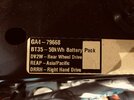Hi all,
After clarifications for someone who's new to Tesla/EV. Apologies if these have been asked before.
From what I've read, the treatment of charging the battery are different. Is the below a correct view of the standard usable range?
RWD
• Total Range: 491km
• Effective Range: 90% (100% - 10%)
• Standard usable range: 441.9km
Long Range
• Total Range: 614km
• Effective Range: 60% (80% - 20%)
• Standard usable range: 368.4km
Home solar panels. I don't currently have solar at home but was considering getting a 4kw unit (have gas water/cooking). If I do get a Tesla, what larger size unit should I be getting instead? I currently drive around 10-15kms per year.
I tried looking at the corporate benefits to see which companies are applicable but could only find the medical association. Is there a list of companies available?
Thanks in advance
After clarifications for someone who's new to Tesla/EV. Apologies if these have been asked before.
From what I've read, the treatment of charging the battery are different. Is the below a correct view of the standard usable range?
RWD
• Total Range: 491km
• Effective Range: 90% (100% - 10%)
• Standard usable range: 441.9km
Long Range
• Total Range: 614km
• Effective Range: 60% (80% - 20%)
• Standard usable range: 368.4km
Home solar panels. I don't currently have solar at home but was considering getting a 4kw unit (have gas water/cooking). If I do get a Tesla, what larger size unit should I be getting instead? I currently drive around 10-15kms per year.
I tried looking at the corporate benefits to see which companies are applicable but could only find the medical association. Is there a list of companies available?
Thanks in advance



